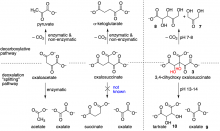Although polysaccharides represent the largest class of biopolymers (by mass), there have been very few investigations into the origins of polysaccharides. This lack of progress may be due, in part, to the fact that the formose reaction (a long-accepted formaldehyde-based model prebiotic reaction for sugar synthesis) produces myriad products, with the sugars of extant life (i.e., ribose, glucose) representing only minor products (ca. 1%). CCE investigations of glyoxylate as a possible source molecule for carbohydrates resulted in the discovery of high yielding syntheses of sugars and sugar acids. CCE researchers are now using this foothold to explore possible prebiotic origins of polysaccharides, as well as the origins of metabolic cycles (e.g., the citric acid cycle).
 Alternative Pathways for the Formation of Linear Sugars
Alternative Pathways for the Formation of Linear Sugars
Explorations of an alternative pathway to sugar formation, called the Glyoxylose scenario, allow CCE researchers access to significant yields of sugars and sugar acids. Cyanide-catalyzed dimerization of glyoxylate to dihydroxyfumarate results in an abiotic pathway to the formation of tartrates. This particular pathway is of key interest when considering prebiotic (abiotic) metabolic pathways, as simple reactions such as dehydration and decarboxylation could lead to the formation of oxaloacetate and pyruvate, which are both relevant to the citric acid cycle.
 Alternative Environments Influence Product Formation
Alternative Environments Influence Product Formation
Building off of the cyanide-catalyzed dimerization of glyoxylate, CCE researchers recently demonstrated a strong pH dependence on product formation when dihydroxyfumarate reacts with glyoxylate and formaldehyde. There are two distinct pathways thus far defined: at pH 7-8 decarboxylation of an intermediate is the sole reaction pathway observed, whereas at pH 13-14, products formed exclusively from a hydroxide-promoted fragmentation are observed. The pathways and products observed have parallels to enzymatic pathways found in extant metabolism, possibly suggesting viable routes to prebiotic metabolites.


